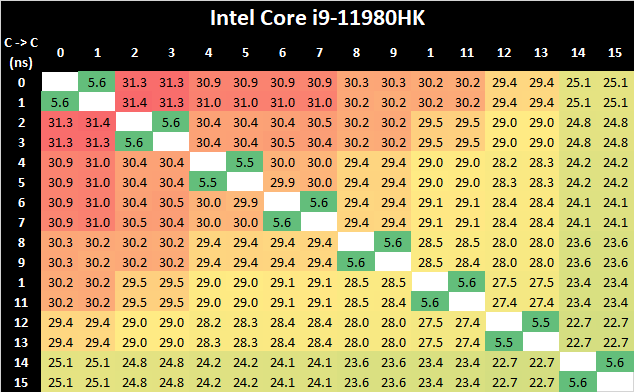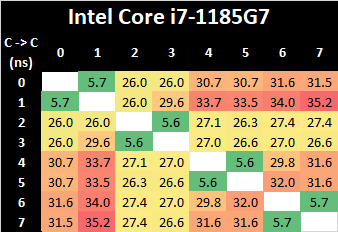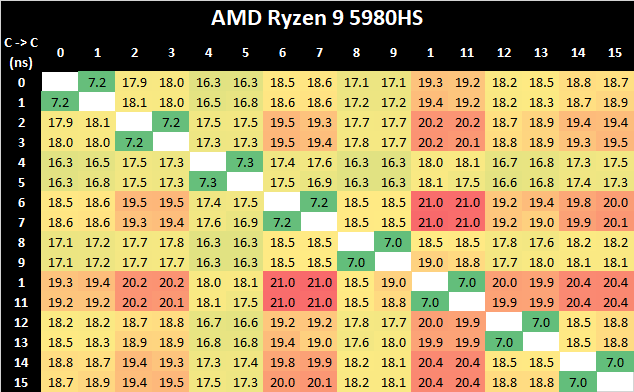Intel 11th Generation Core Tiger Lake-H Performance Review: Fast and Power Hungry
by Brett Howse & Andrei Frumusanu on May 17, 2021 9:00 AM EST- Posted in
- CPUs
- Intel
- 10nm
- Willow Cove
- SuperFin
- 11th Gen
- Tiger Lake-H
CPU Tests: Microbenchmarks
Core-to-Core Latency
As the core count of modern CPUs is growing, we are reaching a time when the time to access each core from a different core is no longer a constant. Even before the advent of heterogeneous SoC designs, processors built on large rings or meshes can have different latencies to access the nearest core compared to the furthest core. This rings true especially in multi-socket server environments.
But modern CPUs, even desktop and consumer CPUs, can have variable access latency to get to another core. For example, in the first generation Threadripper CPUs, we had four chips on the package, each with 8 threads, and each with a different core-to-core latency depending on if it was on-die or off-die. This gets more complex with products like Lakefield, which has two different communication buses depending on which core is talking to which.
If you are a regular reader of AnandTech’s CPU reviews, you will recognize our Core-to-Core latency test. It’s a great way to show exactly how groups of cores are laid out on the silicon. This is a custom in-house test built by Andrei, and we know there are competing tests out there, but we feel ours is the most accurate to how quick an access between two cores can happen.
In terms of the core-to-core tests on the Tiger Lake-H 11980HK, it’s best to actually compare results 1:1 alongside the 4-core Tiger Lake design such as the i7-1185G7:
What’s very interesting in these results is that although the new 8-core design features double the cores, representing a larger ring-bus with more ring stops and cache slices, is that the core-to-core latencies are actually lower both in terms of best-case and worst-case results compared to the 4-core Tiger Lake chip.
This is generally a bit perplexing and confusing, generally the one thing to account for such a difference would be either faster CPU frequencies, or a faster clock of lower cycle latency of the L3 and the ring bus. Given that TGL-H comes 8 months after TGL-U, it is plausible that the newer chip has a more matured implementation and Intel would have been able to optimise access latencies.
Due to AMD’s recent shift to a 8-core core complex, Intel no longer has an advantage in core-to-core latencies this generation, and AMD’s more hierarchical cache structure and interconnect fabric is able to showcase better performance.
Cache & DRAM Latency
This is another in-house test built by Andrei, which showcases the access latency at all the points in the cache hierarchy for a single core. We start at 2 KiB, and probe the latency all the way through to 256 MB, which for most CPUs sits inside the DRAM (before you start saying 64-core TR has 256 MB of L3, it’s only 16 MB per core, so at 20 MB you are in DRAM).
Part of this test helps us understand the range of latencies for accessing a given level of cache, but also the transition between the cache levels gives insight into how different parts of the cache microarchitecture work, such as TLBs. As CPU microarchitects look at interesting and novel ways to design caches upon caches inside caches, this basic test proves to be very valuable.
What’s of particular note for TGL-H is the fact that the new higher-end chip does not have support for LPDDR4, instead exclusively relying on DDR4-3200 as on this reference laptop configuration. This does favour the chip in terms of memory latency, which now falls in at a measured 101ns versus 108ns on the reference TGL-U platform we tested last year, but does come at a cost of memory bandwidth, which is now only reaching a theoretical peak of 51.2GB/s instead of 68.2GB/s – even with double the core count.
What’s in favour of the TGL-H system is the increased L3 cache from 12MB to 24MB – this is still 3MB per core slice as on TGL-U, so it does come with the newer L3 design which was introduced in TGL-U. Nevertheless, this fact, we do see some differences in the L3 behaviour; the TGL-H system has slightly higher access latencies at the same test depth than the TGL-U system, even accounting for the fact that the TGL-H CPUs are clocked slightly higher and have better L1 and L2 latencies. This is an interesting contradiction in context of the improved core-to-core latency results we just saw before, which means that for the latter Intel did make some changes to the fabric. Furthermore, we see flatter access latencies across the L3 depth, which isn’t quite how the TGL-U system behaved, meaning Intel definitely has made some changes as to how the L3 is accessed.














229 Comments
View All Comments
Ppietra - Monday, May 17, 2021 - link
The M1 Mac mini peak power makes no sense in that graph!You are comparing the Mac mini Total Power Draw on the Wall, with other devices’ CPU peak power - clearly completely different things.
Andrei Frumusanu - Monday, May 17, 2021 - link
I think that was a leftover from Ian or a misunderstanding, the M1 does have around 32W peak package power, but you're right, CPU only is only around 21W, I've edited that.Ppietra - Monday, May 17, 2021 - link
ok! I understand, I think it was the data from the original article where you weren’t able to measure CPU power. The value makes more sense now.yankeeDDL - Monday, May 17, 2021 - link
This is not surprising, and it is in line with the TL-U results.I think TL-U is a compelling option, but given the possibility, I'd go for an AMD-based laptop: 30 more minutes of battery life are well worth 7-10% single-core performance disadvantage, all the rest considered. IMHO.
tipoo - Monday, May 17, 2021 - link
Moar 👏Watts 👏Feels like all Intel has now
jagoanjoko - Monday, May 17, 2021 - link
Damn I still expect a little bit better (or much better) result from H45. Many Core i7 10870H can reach 1.600+ points on Cinebench R15 MT. We suppose to wait for final product. But still too disappointing :(Fortunately intel will trading blow with AMD today and for the rest of 2021. Intel can't be strong enough to compete with AMD if they haven't TGL-H45 series
Yojimbo - Monday, May 17, 2021 - link
Isn't the unplugged, battery-only behavior the power usage that matters for a laptop?jagoanjoko - Monday, May 17, 2021 - link
I think it's matter for ultrabook and any ultra portable laptopsAnd become less relevant for thicker laptops
But it's nice to have decent battery life on your thicker laptops so you don't have to bring those heavy charging bricks all times.
mode_13h - Monday, May 17, 2021 - link
Ask people who run demanding games or run heavy workloads on their laptops (who are precisely the market for this thing) and you'll probably find they spend most of their time plugged in.Yojimbo - Monday, May 17, 2021 - link
I myself have a desktop replacement laptop that I use almost exclusively plugged in. When it's plugged in I certainly care about noise, but I don't care about power usage. However I do sometimes use it on battery power, both on power hungry tasks (with which I try to have it plugged in when running) and less power-hungry tasks. That's when battery life, and hence power draw, becomes important to me for the laptop.So, although I use my laptop mostly plugged in and I do care about power draw, the power draw I care about is almost entirely for when the laptop is unplugged. And of course I also care about the performance I get for that power draw in those situations. The noise factor must be considered exclusively laptop to laptop, so looking at power draw in plugged in situations isn't very useful. And frankly, I can't see a good reason that many consumers to be looking at the situation differently and would be concerned about the power draw of the laptop when plugged in.